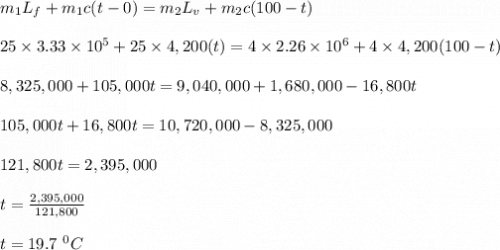
Physics, 30.06.2021 19:30, Quanashiar
If 25 kg of ice at 0°C is combined with 4 kg of steam at 100°C, what will be the final equilibrium temperature (in °C) of the system?

Answers: 1
Other questions on the subject: Physics

Physics, 22.06.2019 07:00, nanakwameyeb
Abucket full of water weights 4 kg and water well is 10m deep. a girl draws water from the well. it takes the girl 3 minutes to draw a bucket full of water from the well. what is the power of the girl?
Answers: 1

Physics, 22.06.2019 19:00, Drea1385
The particle p starts from rest at point a at time t = 0 and changes its speed thereafter at a constant rate of 2.8g as it follows the horizontal path shown. determine the magnitude and direction of its total acceleration (a) just before point b, (b) just after point b, and (c) as it passes point c. state your directions relative to the x-axis shown (ccw positive) and choose the angle with the smallest magnitude.
Answers: 1

Physics, 22.06.2019 23:30, ghari112345
How is the ideal mechanical advantage of a wheel and axle calculated?
Answers: 1

Physics, 23.06.2019 03:20, marshaehayes9444
Neutrons are placed in a magnetic field with magnitude 2.30 t. part a part complete what is the energy difference between the states with the nuclear spin angular momentum components parallel and antiparallel to the field? δe δ e = 2.77×10−7 ev previous answers correct part b part complete which state is lower in energy: the one with its spin component parallel to the field or the one with its spin component antiparallel to the field? which state is lower in energy: the one with its spin component parallel to the field or the one with its spin component antiparallel to the field? parallel antiparallel previous answers correct part c part complete how do your results compare with the energy states for a proton in the same field (δe=4.05×10−7ev)? how do your results compare with the energy states for a proton in the same field this result is smaller than but comparable to that found in the example for protons. this result is greater than but comparable to that found in the example for protons. previous answers correct part d the neutrons can make transitions from one of these states to the other by emitting or absorbing a photon with energy equal to the energy difference of the two states. find the frequency of such a photon. f f = mhz previous answersrequest answer incorrect; try again; 5 attempts remaining
Answers: 2
Do you know the correct answer?
If 25 kg of ice at 0°C is combined with 4 kg of steam at 100°C, what will be the final equilibrium t...
Questions in other subjects:


Biology, 03.09.2021 06:50





Mathematics, 03.09.2021 06:50


Computers and Technology, 03.09.2021 06:50

Mathematics, 03.09.2021 06:50








